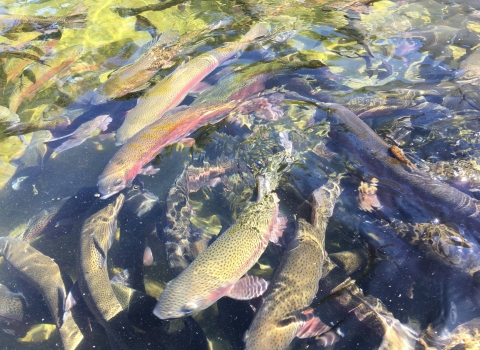The U.S. Fish and Wildlife Service acquired 159 acres of grassland and forested wetland from sisters Lynn, Dee and Marci in April of this year. The land is a portion of the farm on Hog in West Swanton formerly operated by the late John and Erma H. Carman. It is also located very strategically across the road from the new Missisquoi National Wildlife Refuge Headquarters on Tabor Road.
This new parcel has already proven its value to migratory birds," said Mark Sweeny, Refuge Manager. "It's given us a very nice wildlife show this spring".
Unusually high water levels in Lake Champlain have created favorable conditions for some very spectacular migratory bird sightings here, according to Sweeny.
"Seven thousand migrating snow geese and Canada geese stopped on this new addition to the refuge about a month ago, compared with the few I?ve seen in years past. There are also wonderful opportunities to watch and photograph ducks, American bitterns, Great Blue Herons, kestrels and many other birds right from the refuge parking lot. The meadowlarks started arriving last week from their southern wintering area, and the bobolinks are arriving right now," said Sweeny.
This parcel will be managed primarily to provide nesting habitat for grassland nesting birds whose populations are in decline in the Northeast. "People will also be interested to learn that this land is important to spawning fish such as northern pike, walleyes, yellow perch, and many other species that can access the land from Lake Champlain through a culvert under Route 78.
Funds for the acquisition were approved by the Migratory Bird Conservation Commission and were raised from the sale of the Migratory Bird Hunting and Conservation Stamp which is bought annually by duck and goose hunters, conservationists, and stamp collectors. Most of the land within the Missisquoi National Wildlife Refuge has been purchased with these funds.
The now 6,729-acre refuge includes most of the Missisquoi River delta where it flows into Missisquoi Bay. The refuge is one link in a chain of refuges for migratory birds extending along the Atlantic Flyway between northern breeding grounds and southern wintering areas. It provides important habitat for migratory birds, especially waterfowl, in the northern Lake Champlain section of the flyway. The refuge also provides important spawning areas for pickerel, northern pike and carp.
The annual International Migratory Bird Day Celebration, held this year on May 10, celebrates the animal kingdoms frequent fliers and the marvelous journey birds undertake between their summer and winter homes. The nearly 550 national wildlife refuges in the United States are home to hundreds of species of migratory birds.


